Comparative Financial Analysis: J Sainsbury vs. Tesco (Finance)
VerifiedAdded on 2023/01/13
|10
|2344
|100
Report
AI Summary
This report provides a comprehensive analysis of J Sainsbury's financial performance using key financial principles and ratios. The report begins with an introduction to financial principles and their importance in organizational decision-making, followed by an overview of J Sainsbury's business operations. Task 1 focuses on calculating and interpreting various financial ratios for J Sainsbury from 2016 to 2017, including profitability, liquidity, efficiency, and gearing ratios. The analysis includes gross profit ratio, operating profit ratio, net profit ratio, earnings per share, dividend per share, return on assets, current ratio, quick ratio, asset turnover ratio, inventory turnover ratio, debt-to-equity ratio, and total debt ratio. Task 2 extends the analysis by comparing J Sainsbury's financial performance with its competitor, Tesco, using selected ratios like fixed assets turnover ratio, current ratio, net profit ratio, and gross profit ratio. The report interprets these ratios to assess the relative financial strengths and weaknesses of both companies. The conclusion summarizes the findings, emphasizing the role of financial principles in strategic decision-making and the competitive landscape of the retail industry. The report highlights how effectively J Sainsbury and Tesco apply financial principles and policies in the global market.

Principals of finance
Paraphrase This Document
Need a fresh take? Get an instant paraphrase of this document with our AI Paraphraser

Contents
INTRODUCTION...........................................................................................................................1
Overview of company......................................................................................................................1
Task 1...............................................................................................................................................1
Task 2...............................................................................................................................................5
Conclusion.......................................................................................................................................7
References........................................................................................................................................8
INTRODUCTION...........................................................................................................................1
Overview of company......................................................................................................................1
Task 1...............................................................................................................................................1
Task 2...............................................................................................................................................5
Conclusion.......................................................................................................................................7
References........................................................................................................................................8
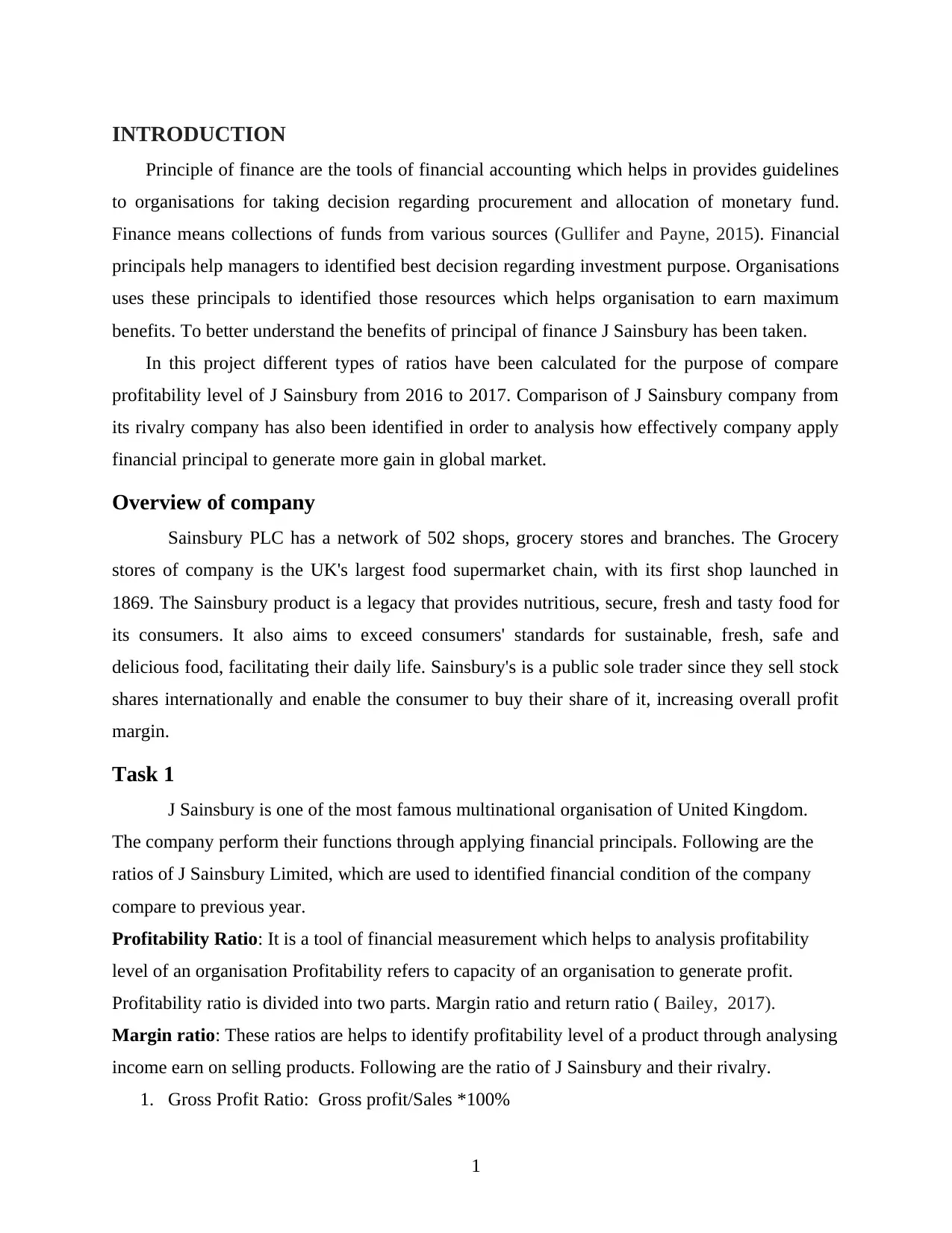
INTRODUCTION
Principle of finance are the tools of financial accounting which helps in provides guidelines
to organisations for taking decision regarding procurement and allocation of monetary fund.
Finance means collections of funds from various sources (Gullifer and Payne, 2015). Financial
principals help managers to identified best decision regarding investment purpose. Organisations
uses these principals to identified those resources which helps organisation to earn maximum
benefits. To better understand the benefits of principal of finance J Sainsbury has been taken.
In this project different types of ratios have been calculated for the purpose of compare
profitability level of J Sainsbury from 2016 to 2017. Comparison of J Sainsbury company from
its rivalry company has also been identified in order to analysis how effectively company apply
financial principal to generate more gain in global market.
Overview of company
Sainsbury PLC has a network of 502 shops, grocery stores and branches. The Grocery
stores of company is the UK's largest food supermarket chain, with its first shop launched in
1869. The Sainsbury product is a legacy that provides nutritious, secure, fresh and tasty food for
its consumers. It also aims to exceed consumers' standards for sustainable, fresh, safe and
delicious food, facilitating their daily life. Sainsbury's is a public sole trader since they sell stock
shares internationally and enable the consumer to buy their share of it, increasing overall profit
margin.
Task 1
J Sainsbury is one of the most famous multinational organisation of United Kingdom.
The company perform their functions through applying financial principals. Following are the
ratios of J Sainsbury Limited, which are used to identified financial condition of the company
compare to previous year.
Profitability Ratio: It is a tool of financial measurement which helps to analysis profitability
level of an organisation Profitability refers to capacity of an organisation to generate profit.
Profitability ratio is divided into two parts. Margin ratio and return ratio ( Bailey, 2017).
Margin ratio: These ratios are helps to identify profitability level of a product through analysing
income earn on selling products. Following are the ratio of J Sainsbury and their rivalry.
1. Gross Profit Ratio: Gross profit/Sales *100%
1
Principle of finance are the tools of financial accounting which helps in provides guidelines
to organisations for taking decision regarding procurement and allocation of monetary fund.
Finance means collections of funds from various sources (Gullifer and Payne, 2015). Financial
principals help managers to identified best decision regarding investment purpose. Organisations
uses these principals to identified those resources which helps organisation to earn maximum
benefits. To better understand the benefits of principal of finance J Sainsbury has been taken.
In this project different types of ratios have been calculated for the purpose of compare
profitability level of J Sainsbury from 2016 to 2017. Comparison of J Sainsbury company from
its rivalry company has also been identified in order to analysis how effectively company apply
financial principal to generate more gain in global market.
Overview of company
Sainsbury PLC has a network of 502 shops, grocery stores and branches. The Grocery
stores of company is the UK's largest food supermarket chain, with its first shop launched in
1869. The Sainsbury product is a legacy that provides nutritious, secure, fresh and tasty food for
its consumers. It also aims to exceed consumers' standards for sustainable, fresh, safe and
delicious food, facilitating their daily life. Sainsbury's is a public sole trader since they sell stock
shares internationally and enable the consumer to buy their share of it, increasing overall profit
margin.
Task 1
J Sainsbury is one of the most famous multinational organisation of United Kingdom.
The company perform their functions through applying financial principals. Following are the
ratios of J Sainsbury Limited, which are used to identified financial condition of the company
compare to previous year.
Profitability Ratio: It is a tool of financial measurement which helps to analysis profitability
level of an organisation Profitability refers to capacity of an organisation to generate profit.
Profitability ratio is divided into two parts. Margin ratio and return ratio ( Bailey, 2017).
Margin ratio: These ratios are helps to identify profitability level of a product through analysing
income earn on selling products. Following are the ratio of J Sainsbury and their rivalry.
1. Gross Profit Ratio: Gross profit/Sales *100%
1
⊘ This is a preview!⊘
Do you want full access?
Subscribe today to unlock all pages.

Trusted by 1+ million students worldwide
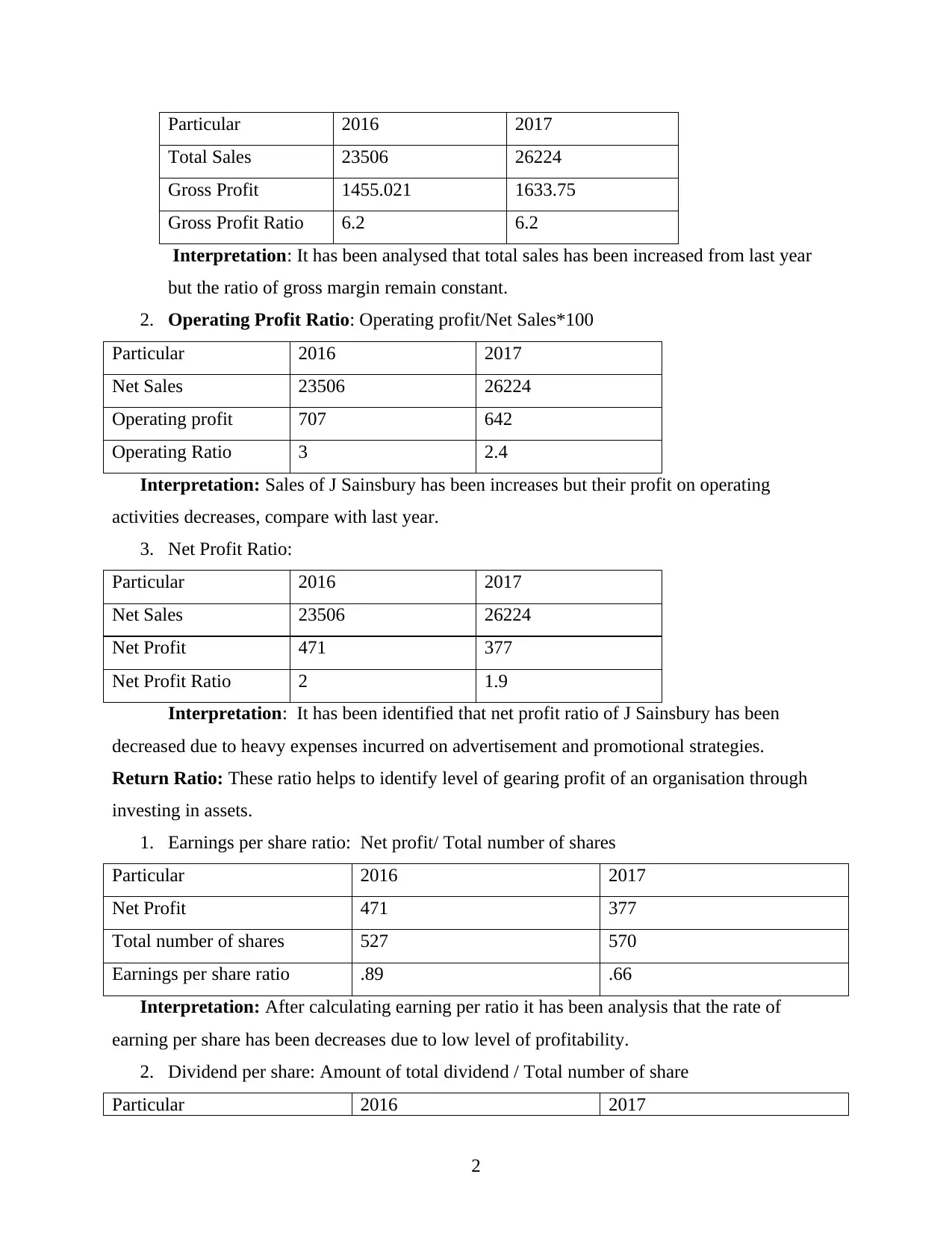
Particular 2016 2017
Total Sales 23506 26224
Gross Profit 1455.021 1633.75
Gross Profit Ratio 6.2 6.2
Interpretation: It has been analysed that total sales has been increased from last year
but the ratio of gross margin remain constant.
2. Operating Profit Ratio: Operating profit/Net Sales*100
Particular 2016 2017
Net Sales 23506 26224
Operating profit 707 642
Operating Ratio 3 2.4
Interpretation: Sales of J Sainsbury has been increases but their profit on operating
activities decreases, compare with last year.
3. Net Profit Ratio:
Particular 2016 2017
Net Sales 23506 26224
Net Profit 471 377
Net Profit Ratio 2 1.9
Interpretation: It has been identified that net profit ratio of J Sainsbury has been
decreased due to heavy expenses incurred on advertisement and promotional strategies.
Return Ratio: These ratio helps to identify level of gearing profit of an organisation through
investing in assets.
1. Earnings per share ratio: Net profit/ Total number of shares
Particular 2016 2017
Net Profit 471 377
Total number of shares 527 570
Earnings per share ratio .89 .66
Interpretation: After calculating earning per ratio it has been analysis that the rate of
earning per share has been decreases due to low level of profitability.
2. Dividend per share: Amount of total dividend / Total number of share
Particular 2016 2017
2
Total Sales 23506 26224
Gross Profit 1455.021 1633.75
Gross Profit Ratio 6.2 6.2
Interpretation: It has been analysed that total sales has been increased from last year
but the ratio of gross margin remain constant.
2. Operating Profit Ratio: Operating profit/Net Sales*100
Particular 2016 2017
Net Sales 23506 26224
Operating profit 707 642
Operating Ratio 3 2.4
Interpretation: Sales of J Sainsbury has been increases but their profit on operating
activities decreases, compare with last year.
3. Net Profit Ratio:
Particular 2016 2017
Net Sales 23506 26224
Net Profit 471 377
Net Profit Ratio 2 1.9
Interpretation: It has been identified that net profit ratio of J Sainsbury has been
decreased due to heavy expenses incurred on advertisement and promotional strategies.
Return Ratio: These ratio helps to identify level of gearing profit of an organisation through
investing in assets.
1. Earnings per share ratio: Net profit/ Total number of shares
Particular 2016 2017
Net Profit 471 377
Total number of shares 527 570
Earnings per share ratio .89 .66
Interpretation: After calculating earning per ratio it has been analysis that the rate of
earning per share has been decreases due to low level of profitability.
2. Dividend per share: Amount of total dividend / Total number of share
Particular 2016 2017
2
Paraphrase This Document
Need a fresh take? Get an instant paraphrase of this document with our AI Paraphraser
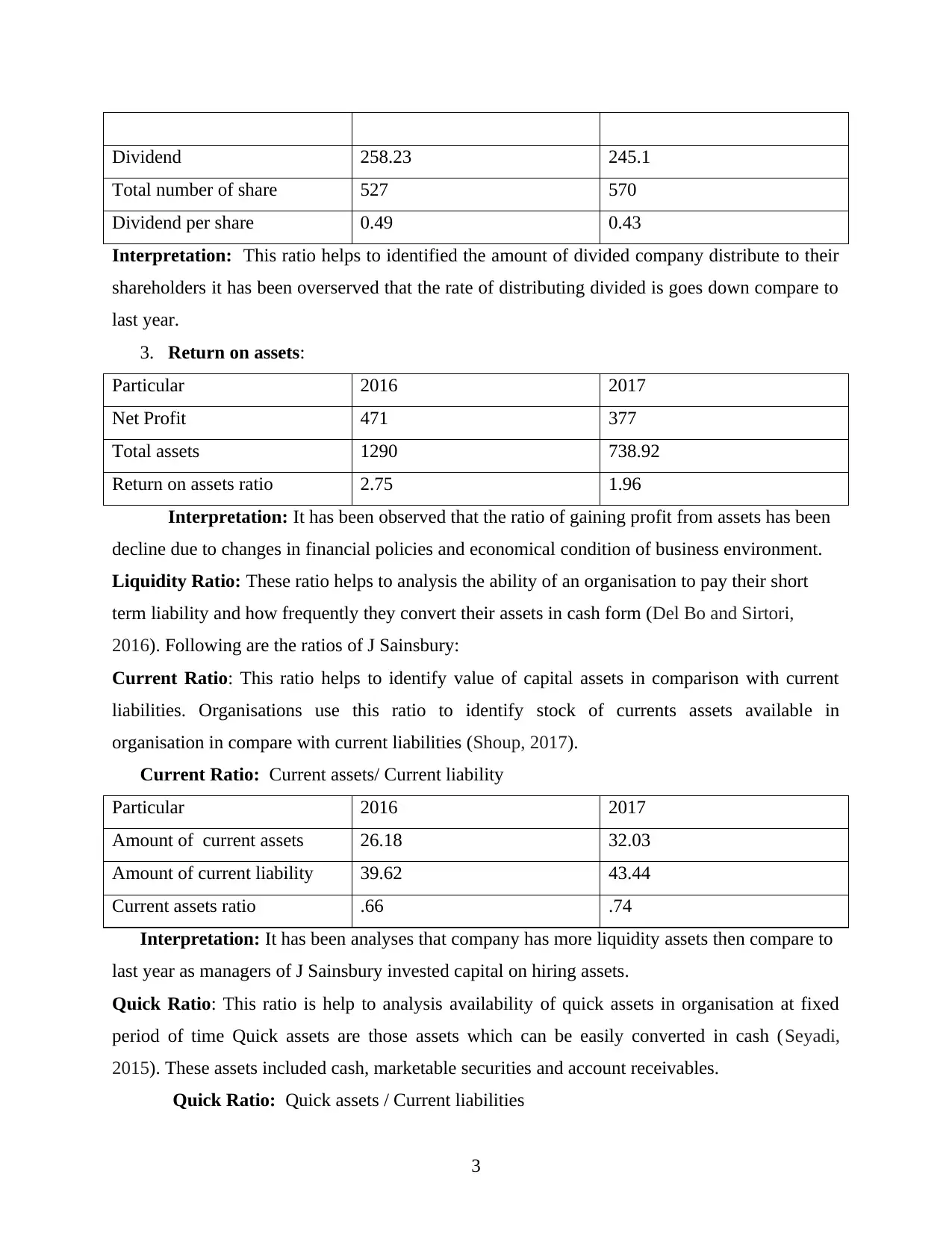
Dividend 258.23 245.1
Total number of share 527 570
Dividend per share 0.49 0.43
Interpretation: This ratio helps to identified the amount of divided company distribute to their
shareholders it has been overserved that the rate of distributing divided is goes down compare to
last year.
3. Return on assets:
Particular 2016 2017
Net Profit 471 377
Total assets 1290 738.92
Return on assets ratio 2.75 1.96
Interpretation: It has been observed that the ratio of gaining profit from assets has been
decline due to changes in financial policies and economical condition of business environment.
Liquidity Ratio: These ratio helps to analysis the ability of an organisation to pay their short
term liability and how frequently they convert their assets in cash form (Del Bo and Sirtori,
2016). Following are the ratios of J Sainsbury:
Current Ratio: This ratio helps to identify value of capital assets in comparison with current
liabilities. Organisations use this ratio to identify stock of currents assets available in
organisation in compare with current liabilities (Shoup, 2017).
Current Ratio: Current assets/ Current liability
Particular 2016 2017
Amount of current assets 26.18 32.03
Amount of current liability 39.62 43.44
Current assets ratio .66 .74
Interpretation: It has been analyses that company has more liquidity assets then compare to
last year as managers of J Sainsbury invested capital on hiring assets.
Quick Ratio: This ratio is help to analysis availability of quick assets in organisation at fixed
period of time Quick assets are those assets which can be easily converted in cash (Seyadi,
2015). These assets included cash, marketable securities and account receivables.
Quick Ratio: Quick assets / Current liabilities
3
Total number of share 527 570
Dividend per share 0.49 0.43
Interpretation: This ratio helps to identified the amount of divided company distribute to their
shareholders it has been overserved that the rate of distributing divided is goes down compare to
last year.
3. Return on assets:
Particular 2016 2017
Net Profit 471 377
Total assets 1290 738.92
Return on assets ratio 2.75 1.96
Interpretation: It has been observed that the ratio of gaining profit from assets has been
decline due to changes in financial policies and economical condition of business environment.
Liquidity Ratio: These ratio helps to analysis the ability of an organisation to pay their short
term liability and how frequently they convert their assets in cash form (Del Bo and Sirtori,
2016). Following are the ratios of J Sainsbury:
Current Ratio: This ratio helps to identify value of capital assets in comparison with current
liabilities. Organisations use this ratio to identify stock of currents assets available in
organisation in compare with current liabilities (Shoup, 2017).
Current Ratio: Current assets/ Current liability
Particular 2016 2017
Amount of current assets 26.18 32.03
Amount of current liability 39.62 43.44
Current assets ratio .66 .74
Interpretation: It has been analyses that company has more liquidity assets then compare to
last year as managers of J Sainsbury invested capital on hiring assets.
Quick Ratio: This ratio is help to analysis availability of quick assets in organisation at fixed
period of time Quick assets are those assets which can be easily converted in cash (Seyadi,
2015). These assets included cash, marketable securities and account receivables.
Quick Ratio: Quick assets / Current liabilities
3
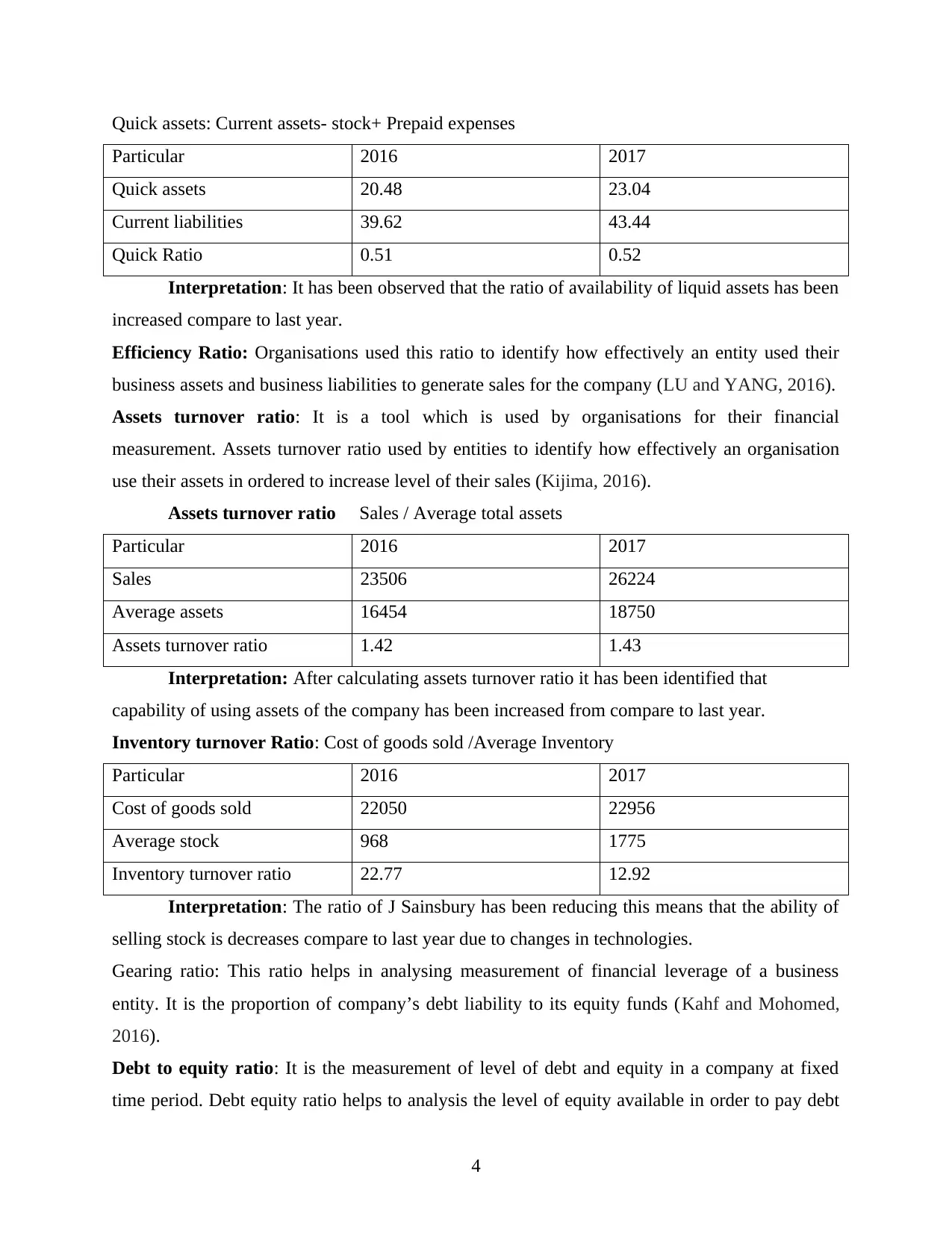
Quick assets: Current assets- stock+ Prepaid expenses
Particular 2016 2017
Quick assets 20.48 23.04
Current liabilities 39.62 43.44
Quick Ratio 0.51 0.52
Interpretation: It has been observed that the ratio of availability of liquid assets has been
increased compare to last year.
Efficiency Ratio: Organisations used this ratio to identify how effectively an entity used their
business assets and business liabilities to generate sales for the company (LU and YANG, 2016).
Assets turnover ratio: It is a tool which is used by organisations for their financial
measurement. Assets turnover ratio used by entities to identify how effectively an organisation
use their assets in ordered to increase level of their sales (Kijima, 2016).
Assets turnover ratio Sales / Average total assets
Particular 2016 2017
Sales 23506 26224
Average assets 16454 18750
Assets turnover ratio 1.42 1.43
Interpretation: After calculating assets turnover ratio it has been identified that
capability of using assets of the company has been increased from compare to last year.
Inventory turnover Ratio: Cost of goods sold /Average Inventory
Particular 2016 2017
Cost of goods sold 22050 22956
Average stock 968 1775
Inventory turnover ratio 22.77 12.92
Interpretation: The ratio of J Sainsbury has been reducing this means that the ability of
selling stock is decreases compare to last year due to changes in technologies.
Gearing ratio: This ratio helps in analysing measurement of financial leverage of a business
entity. It is the proportion of company’s debt liability to its equity funds (Kahf and Mohomed,
2016).
Debt to equity ratio: It is the measurement of level of debt and equity in a company at fixed
time period. Debt equity ratio helps to analysis the level of equity available in order to pay debt
4
Particular 2016 2017
Quick assets 20.48 23.04
Current liabilities 39.62 43.44
Quick Ratio 0.51 0.52
Interpretation: It has been observed that the ratio of availability of liquid assets has been
increased compare to last year.
Efficiency Ratio: Organisations used this ratio to identify how effectively an entity used their
business assets and business liabilities to generate sales for the company (LU and YANG, 2016).
Assets turnover ratio: It is a tool which is used by organisations for their financial
measurement. Assets turnover ratio used by entities to identify how effectively an organisation
use their assets in ordered to increase level of their sales (Kijima, 2016).
Assets turnover ratio Sales / Average total assets
Particular 2016 2017
Sales 23506 26224
Average assets 16454 18750
Assets turnover ratio 1.42 1.43
Interpretation: After calculating assets turnover ratio it has been identified that
capability of using assets of the company has been increased from compare to last year.
Inventory turnover Ratio: Cost of goods sold /Average Inventory
Particular 2016 2017
Cost of goods sold 22050 22956
Average stock 968 1775
Inventory turnover ratio 22.77 12.92
Interpretation: The ratio of J Sainsbury has been reducing this means that the ability of
selling stock is decreases compare to last year due to changes in technologies.
Gearing ratio: This ratio helps in analysing measurement of financial leverage of a business
entity. It is the proportion of company’s debt liability to its equity funds (Kahf and Mohomed,
2016).
Debt to equity ratio: It is the measurement of level of debt and equity in a company at fixed
time period. Debt equity ratio helps to analysis the level of equity available in order to pay debt
4
⊘ This is a preview!⊘
Do you want full access?
Subscribe today to unlock all pages.

Trusted by 1+ million students worldwide
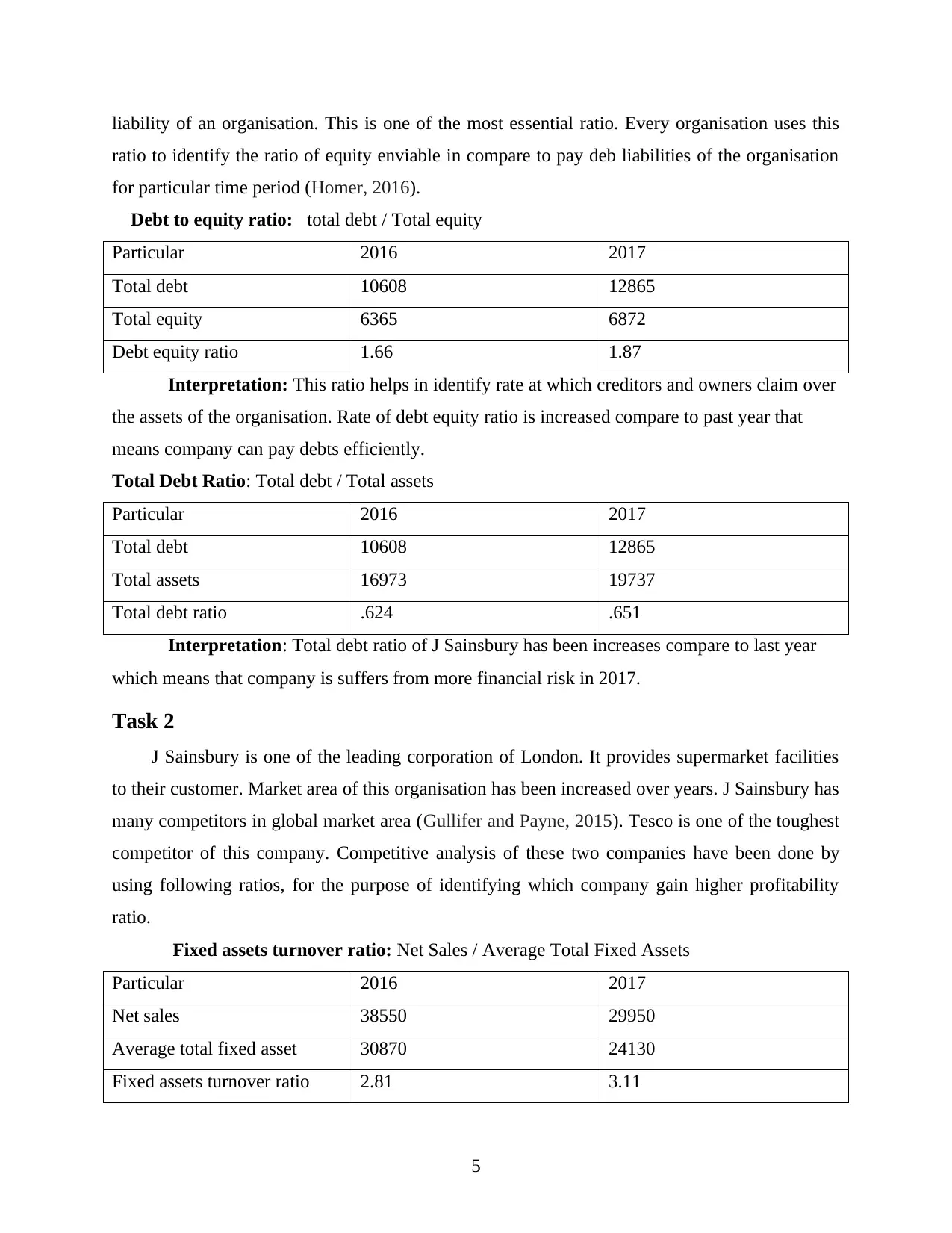
liability of an organisation. This is one of the most essential ratio. Every organisation uses this
ratio to identify the ratio of equity enviable in compare to pay deb liabilities of the organisation
for particular time period (Homer, 2016).
Debt to equity ratio: total debt / Total equity
Particular 2016 2017
Total debt 10608 12865
Total equity 6365 6872
Debt equity ratio 1.66 1.87
Interpretation: This ratio helps in identify rate at which creditors and owners claim over
the assets of the organisation. Rate of debt equity ratio is increased compare to past year that
means company can pay debts efficiently.
Total Debt Ratio: Total debt / Total assets
Particular 2016 2017
Total debt 10608 12865
Total assets 16973 19737
Total debt ratio .624 .651
Interpretation: Total debt ratio of J Sainsbury has been increases compare to last year
which means that company is suffers from more financial risk in 2017.
Task 2
J Sainsbury is one of the leading corporation of London. It provides supermarket facilities
to their customer. Market area of this organisation has been increased over years. J Sainsbury has
many competitors in global market area (Gullifer and Payne, 2015). Tesco is one of the toughest
competitor of this company. Competitive analysis of these two companies have been done by
using following ratios, for the purpose of identifying which company gain higher profitability
ratio.
Fixed assets turnover ratio: Net Sales / Average Total Fixed Assets
Particular 2016 2017
Net sales 38550 29950
Average total fixed asset 30870 24130
Fixed assets turnover ratio 2.81 3.11
5
ratio to identify the ratio of equity enviable in compare to pay deb liabilities of the organisation
for particular time period (Homer, 2016).
Debt to equity ratio: total debt / Total equity
Particular 2016 2017
Total debt 10608 12865
Total equity 6365 6872
Debt equity ratio 1.66 1.87
Interpretation: This ratio helps in identify rate at which creditors and owners claim over
the assets of the organisation. Rate of debt equity ratio is increased compare to past year that
means company can pay debts efficiently.
Total Debt Ratio: Total debt / Total assets
Particular 2016 2017
Total debt 10608 12865
Total assets 16973 19737
Total debt ratio .624 .651
Interpretation: Total debt ratio of J Sainsbury has been increases compare to last year
which means that company is suffers from more financial risk in 2017.
Task 2
J Sainsbury is one of the leading corporation of London. It provides supermarket facilities
to their customer. Market area of this organisation has been increased over years. J Sainsbury has
many competitors in global market area (Gullifer and Payne, 2015). Tesco is one of the toughest
competitor of this company. Competitive analysis of these two companies have been done by
using following ratios, for the purpose of identifying which company gain higher profitability
ratio.
Fixed assets turnover ratio: Net Sales / Average Total Fixed Assets
Particular 2016 2017
Net sales 38550 29950
Average total fixed asset 30870 24130
Fixed assets turnover ratio 2.81 3.11
5
Paraphrase This Document
Need a fresh take? Get an instant paraphrase of this document with our AI Paraphraser
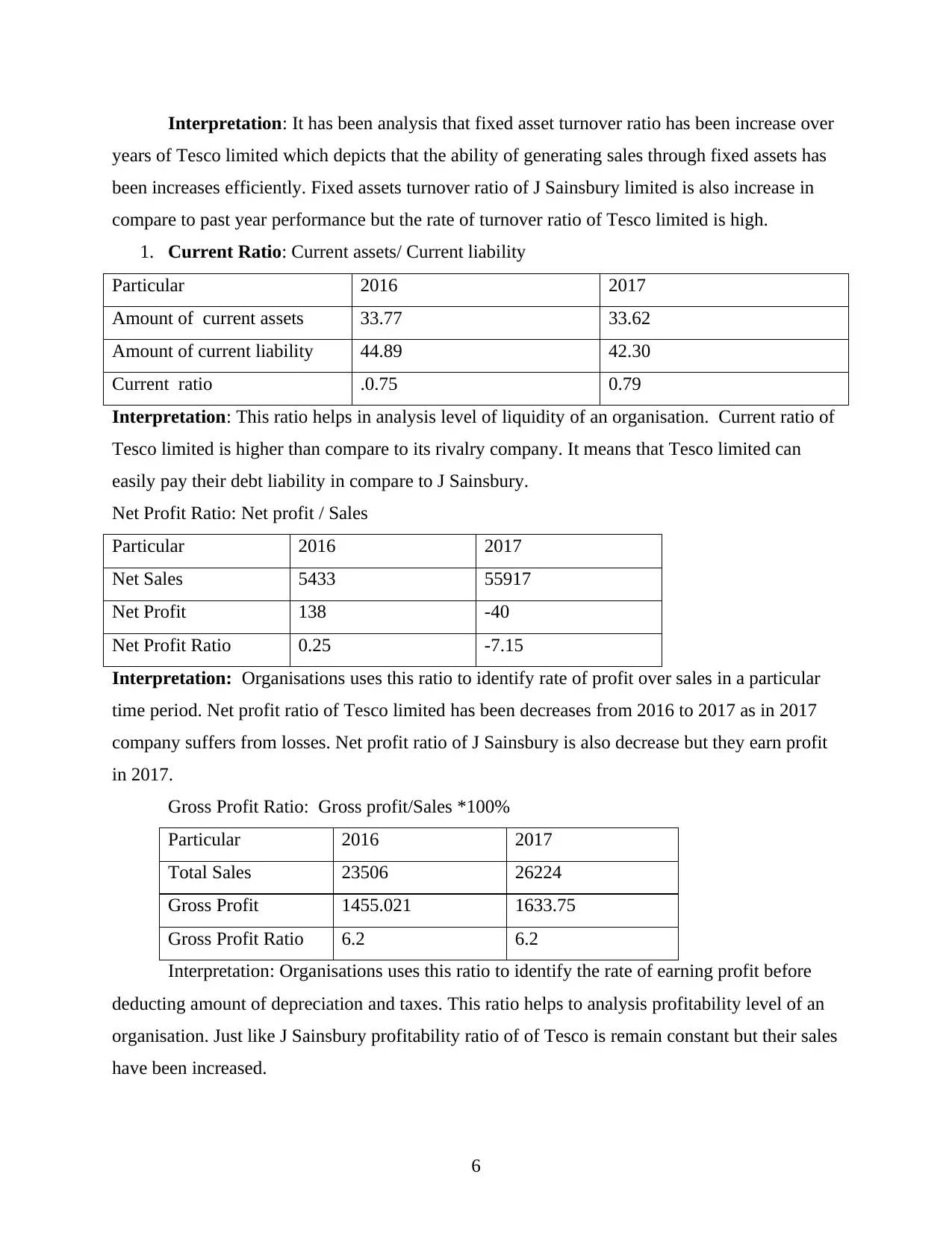
Interpretation: It has been analysis that fixed asset turnover ratio has been increase over
years of Tesco limited which depicts that the ability of generating sales through fixed assets has
been increases efficiently. Fixed assets turnover ratio of J Sainsbury limited is also increase in
compare to past year performance but the rate of turnover ratio of Tesco limited is high.
1. Current Ratio: Current assets/ Current liability
Particular 2016 2017
Amount of current assets 33.77 33.62
Amount of current liability 44.89 42.30
Current ratio .0.75 0.79
Interpretation: This ratio helps in analysis level of liquidity of an organisation. Current ratio of
Tesco limited is higher than compare to its rivalry company. It means that Tesco limited can
easily pay their debt liability in compare to J Sainsbury.
Net Profit Ratio: Net profit / Sales
Particular 2016 2017
Net Sales 5433 55917
Net Profit 138 -40
Net Profit Ratio 0.25 -7.15
Interpretation: Organisations uses this ratio to identify rate of profit over sales in a particular
time period. Net profit ratio of Tesco limited has been decreases from 2016 to 2017 as in 2017
company suffers from losses. Net profit ratio of J Sainsbury is also decrease but they earn profit
in 2017.
Gross Profit Ratio: Gross profit/Sales *100%
Particular 2016 2017
Total Sales 23506 26224
Gross Profit 1455.021 1633.75
Gross Profit Ratio 6.2 6.2
Interpretation: Organisations uses this ratio to identify the rate of earning profit before
deducting amount of depreciation and taxes. This ratio helps to analysis profitability level of an
organisation. Just like J Sainsbury profitability ratio of of Tesco is remain constant but their sales
have been increased.
6
years of Tesco limited which depicts that the ability of generating sales through fixed assets has
been increases efficiently. Fixed assets turnover ratio of J Sainsbury limited is also increase in
compare to past year performance but the rate of turnover ratio of Tesco limited is high.
1. Current Ratio: Current assets/ Current liability
Particular 2016 2017
Amount of current assets 33.77 33.62
Amount of current liability 44.89 42.30
Current ratio .0.75 0.79
Interpretation: This ratio helps in analysis level of liquidity of an organisation. Current ratio of
Tesco limited is higher than compare to its rivalry company. It means that Tesco limited can
easily pay their debt liability in compare to J Sainsbury.
Net Profit Ratio: Net profit / Sales
Particular 2016 2017
Net Sales 5433 55917
Net Profit 138 -40
Net Profit Ratio 0.25 -7.15
Interpretation: Organisations uses this ratio to identify rate of profit over sales in a particular
time period. Net profit ratio of Tesco limited has been decreases from 2016 to 2017 as in 2017
company suffers from losses. Net profit ratio of J Sainsbury is also decrease but they earn profit
in 2017.
Gross Profit Ratio: Gross profit/Sales *100%
Particular 2016 2017
Total Sales 23506 26224
Gross Profit 1455.021 1633.75
Gross Profit Ratio 6.2 6.2
Interpretation: Organisations uses this ratio to identify the rate of earning profit before
deducting amount of depreciation and taxes. This ratio helps to analysis profitability level of an
organisation. Just like J Sainsbury profitability ratio of of Tesco is remain constant but their sales
have been increased.
6
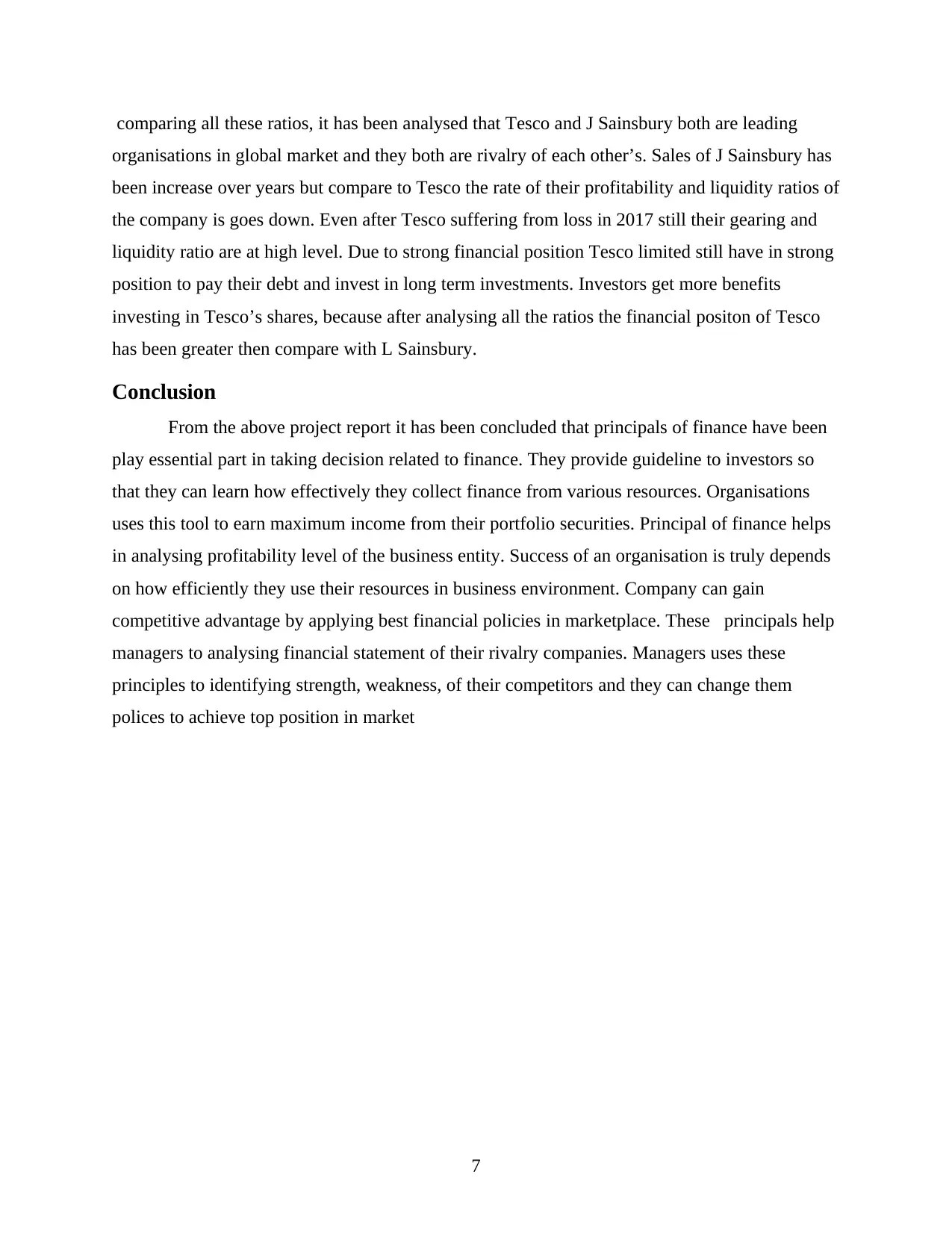
comparing all these ratios, it has been analysed that Tesco and J Sainsbury both are leading
organisations in global market and they both are rivalry of each other’s. Sales of J Sainsbury has
been increase over years but compare to Tesco the rate of their profitability and liquidity ratios of
the company is goes down. Even after Tesco suffering from loss in 2017 still their gearing and
liquidity ratio are at high level. Due to strong financial position Tesco limited still have in strong
position to pay their debt and invest in long term investments. Investors get more benefits
investing in Tesco’s shares, because after analysing all the ratios the financial positon of Tesco
has been greater then compare with L Sainsbury.
Conclusion
From the above project report it has been concluded that principals of finance have been
play essential part in taking decision related to finance. They provide guideline to investors so
that they can learn how effectively they collect finance from various resources. Organisations
uses this tool to earn maximum income from their portfolio securities. Principal of finance helps
in analysing profitability level of the business entity. Success of an organisation is truly depends
on how efficiently they use their resources in business environment. Company can gain
competitive advantage by applying best financial policies in marketplace. These principals help
managers to analysing financial statement of their rivalry companies. Managers uses these
principles to identifying strength, weakness, of their competitors and they can change them
polices to achieve top position in market
7
organisations in global market and they both are rivalry of each other’s. Sales of J Sainsbury has
been increase over years but compare to Tesco the rate of their profitability and liquidity ratios of
the company is goes down. Even after Tesco suffering from loss in 2017 still their gearing and
liquidity ratio are at high level. Due to strong financial position Tesco limited still have in strong
position to pay their debt and invest in long term investments. Investors get more benefits
investing in Tesco’s shares, because after analysing all the ratios the financial positon of Tesco
has been greater then compare with L Sainsbury.
Conclusion
From the above project report it has been concluded that principals of finance have been
play essential part in taking decision related to finance. They provide guideline to investors so
that they can learn how effectively they collect finance from various resources. Organisations
uses this tool to earn maximum income from their portfolio securities. Principal of finance helps
in analysing profitability level of the business entity. Success of an organisation is truly depends
on how efficiently they use their resources in business environment. Company can gain
competitive advantage by applying best financial policies in marketplace. These principals help
managers to analysing financial statement of their rivalry companies. Managers uses these
principles to identifying strength, weakness, of their competitors and they can change them
polices to achieve top position in market
7
⊘ This is a preview!⊘
Do you want full access?
Subscribe today to unlock all pages.

Trusted by 1+ million students worldwide

References
Books and Journals
Bailey, S. J., 2017. Strategic public finance. Macmillan International Higher Education.
Del Bo, C. F. and Sirtori, E., 2016. Additionality and regional public finance–evidence from
Italy. Environment and Planning C: Government and Policy, 34(5), pp.855-878.
Gullifer, L. and Payne, J., 2015. Corporate finance law: principles and policy. Bloomsbury
Publishing.
Homer, W. W., 2016. Corporation finance. Рипол Классик.
Kahf, M. and Mohomed, A. N., 2016. The Principle of Realism in Islamic Finance. Journal of
Islamic Economics, Banking and Finance, 113(5818), pp.1-29.
Kijima, M., 2016. Stochastic processes with applications to finance. Chapman and Hall/CRC.
LU, M. F. and YANG, L., 2016. A Research on the Derivation and Development of Growth
Chain Finance Principle. Journal of Huaqiao University (Philosophy & Social
Sciences), (2), p.4.
Seyadi, R. M., 2015. Legal Aspect of Islamic Finance. Arab Law Quarterly, 29(3), pp.285-295.
Shoup, C., 2017. Public finance. Routledge.
8
Books and Journals
Bailey, S. J., 2017. Strategic public finance. Macmillan International Higher Education.
Del Bo, C. F. and Sirtori, E., 2016. Additionality and regional public finance–evidence from
Italy. Environment and Planning C: Government and Policy, 34(5), pp.855-878.
Gullifer, L. and Payne, J., 2015. Corporate finance law: principles and policy. Bloomsbury
Publishing.
Homer, W. W., 2016. Corporation finance. Рипол Классик.
Kahf, M. and Mohomed, A. N., 2016. The Principle of Realism in Islamic Finance. Journal of
Islamic Economics, Banking and Finance, 113(5818), pp.1-29.
Kijima, M., 2016. Stochastic processes with applications to finance. Chapman and Hall/CRC.
LU, M. F. and YANG, L., 2016. A Research on the Derivation and Development of Growth
Chain Finance Principle. Journal of Huaqiao University (Philosophy & Social
Sciences), (2), p.4.
Seyadi, R. M., 2015. Legal Aspect of Islamic Finance. Arab Law Quarterly, 29(3), pp.285-295.
Shoup, C., 2017. Public finance. Routledge.
8
1 out of 10
Related Documents
Your All-in-One AI-Powered Toolkit for Academic Success.
+13062052269
info@desklib.com
Available 24*7 on WhatsApp / Email
![[object Object]](/_next/static/media/star-bottom.7253800d.svg)
Unlock your academic potential
Copyright © 2020–2025 A2Z Services. All Rights Reserved. Developed and managed by ZUCOL.





